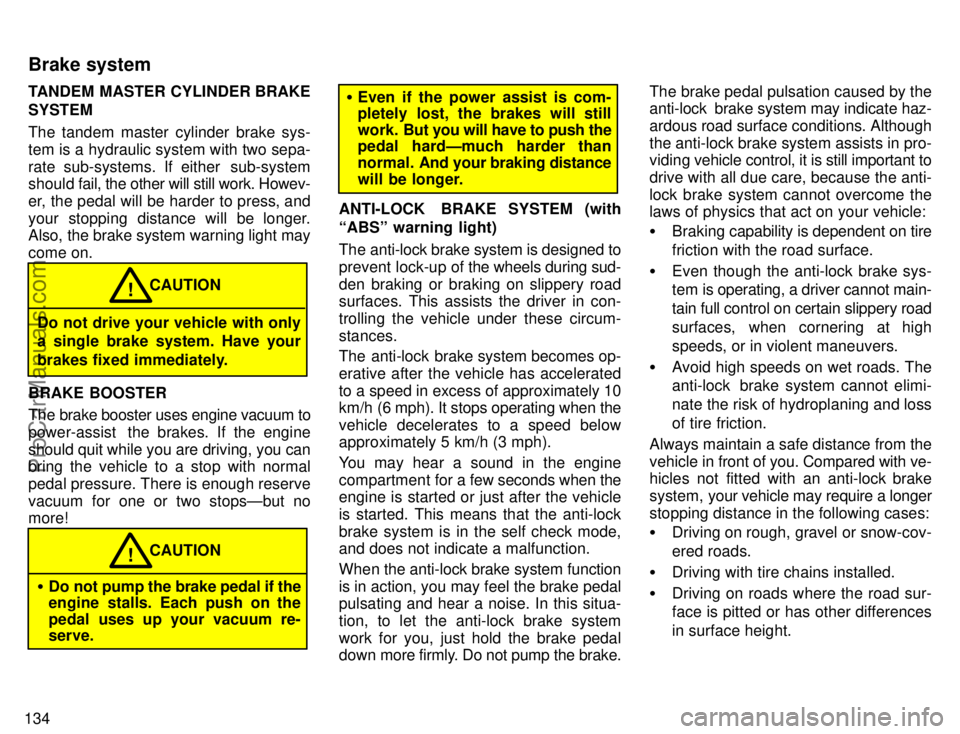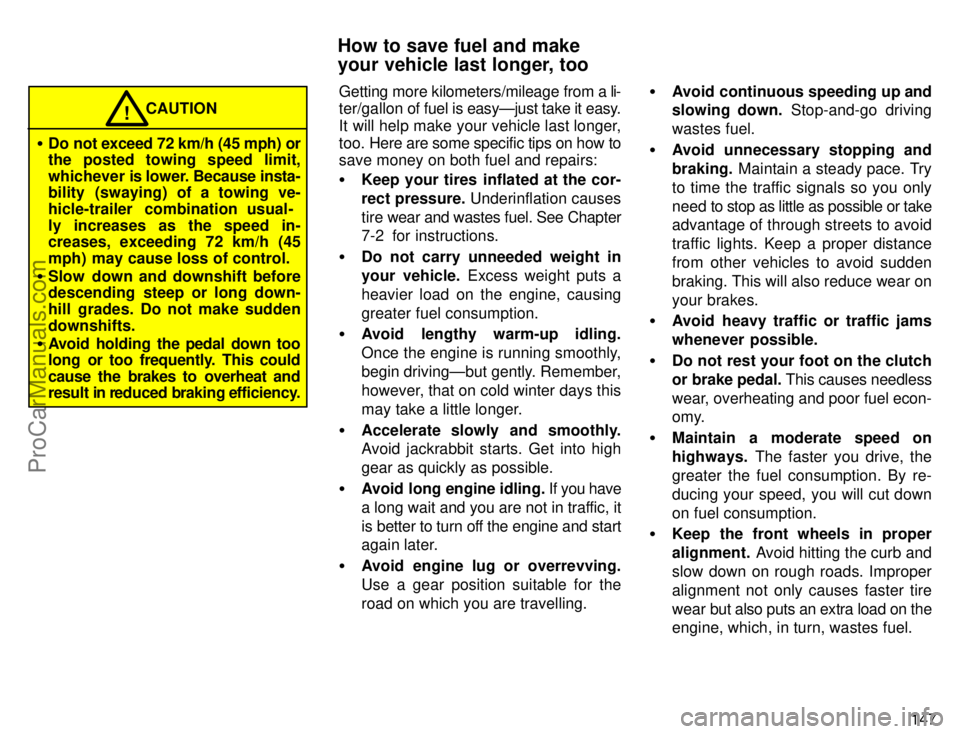Page 140 of 226

134TANDEM MASTER CYLINDER BRAKE
SYSTEM
The tandem master cylinder brake sys-
tem is a hydraulic system with two sepa-
rate sub-systems. If either sub-system
should fail, the other will still work. Howev-
er, the pedal will be harder to press, and
your stopping distance will be longer.
Also, the brake system warning light may
come on.
CAUTION!
Do not drive your vehicle with only
a single brake system. Have your
brakes fixed immediately.
BRAKE BOOSTER
The brake booster uses engine vacuum to
power-assist the brakes. If the engine
should quit while you are driving, you can
bring the vehicle to a stop with normal
pedal pressure. There is enough reserve
vacuum for one or two stopsÐbut no
more!
CAUTION!
�Do not pump the brake pedal if the
engine stalls. Each push on the
pedal uses up your vacuum re-
serve.
�Even if the power assist is com-
pletely lost, the brakes will still
work. But you will have to push the
pedal hardÐmuch harder than
normal. And your braking distance
will be longer.
ANTI-LOCK BRAKE SYSTEM (with
ABSº warning light)
The anti-lock brake system is designed to
prevent lock-up of the wheels during sud-
den braking or braking on slippery road
surfaces. This assists the driver in con-
trolling the vehicle under these circum-
stances.
The anti-lock brake system becomes op-
erative after the vehicle has accelerated
to a speed in excess of approximately 10
km/h (6 mph). It stops operating when the
vehicle decelerates to a speed below
approximately 5 km/h (3 mph).
You may hear a sound in the engine
compartment for a few seconds when the
engine is started or just after the vehicle
is started. This means that the anti-lock
brake system is in the self check mode,
and does not indicate a malfunction.
When the anti-lock brake system function
is in action, you may feel the brake pedal
pulsating and hear a noise. In this situa-
tion, to let the anti-lock brake system
work for you, just hold the brake pedal
down more firmly. Do not pump the brake.The brake pedal pulsation caused by the
anti-lock brake system may indicate haz-
ardous road surface conditions. Although
the anti-lock brake system assists in pro-
viding vehicle control, it is still important to
drive with all due care, because the anti-
lock brake system cannot overcome the
laws of physics that act on your vehicle:
�Braking capability is dependent on tire
friction with the road surface.
�Even though the anti-lock brake sys-
tem is operating, a driver cannot main-
tain full control on certain slippery road
surfaces, when cornering at high
speeds, or in violent maneuvers.
�Avoid high speeds on wet roads. The
anti-lock brake system cannot elimi-
nate the risk of hydroplaning and loss
of tire friction.
Always maintain a safe distance from the
vehicle in front of you. Compared with ve-
hicles not fitted with an anti-lock brake
system, your vehicle may require a longer
stopping distance in the following cases:
�Driving on rough, gravel or snow-cov-
ered roads.
�Driving with tire chains installed.
�Driving on roads where the road sur-
face is pitted or has other differences
in surface height.
Brake system
ProCarManuals.com
Page 153 of 226

147
CAUTION!
�Do not exceed 72 km/h (45 mph) or
the posted towing speed limit,
whichever is lower. Because insta-
bility (swaying) of a towing ve-
hicle-trailer combination usual-
ly increases as the speed in-
creases, exceeding 72 km/h (45
mph) may cause loss of control.
�Slow down and downshift before
descending steep or long down-
hill grades. Do not make sudden
downshifts.
�Avoid holding the pedal down too
long or too frequently. This could
cause the brakes to overheat and
result in reduced braking efficiency.Getting more kilometers/mileage from a li-
ter/gallon of fuel is easyÐjust take it easy.
It will help make your vehicle last longer,
too. Here are some specific tips on how to
save money on both fuel and repairs:
�Keep your tires inflated at the cor-
rect pressure. Underinflation causes
tire wear and wastes fuel. See Chapter
7-2 for instructions.
�Do not carry unneeded weight in
your vehicle. Excess weight puts a
heavier load on the engine, causing
greater fuel consumption.
�Avoid lengthy warm-up idling.
Once the engine is running smoothly,
begin drivingÐbut gently. Remember,
however, that on cold winter days this
may take a little longer.
�Accelerate slowly and smoothly.
Avoid jackrabbit starts. Get into high
gear as quickly as possible.
�Avoid long engine idling. If you have
a long wait and you are not in traffic, it
is better to turn off the engine and start
again later.
�Avoid engine lug or overrevving.
Use a gear position suitable for the
road on which you are travelling.�Avoid continuous speeding up and
slowing down. Stop-and-go driving
wastes fuel.
�Avoid unnecessary stopping and
braking. Maintain a steady pace. Try
to time the traffic signals so you only
need to stop as little as possible or take
advantage of through streets to avoid
traffic lights. Keep a proper distance
from other vehicles to avoid sudden
braking. This will also reduce wear on
your brakes.
�Avoid heavy traffic or traffic jams
whenever possible.
�Do not rest your foot on the clutch
or brake pedal. This causes needless
wear, overheating and poor fuel econ-
omy.
�Maintain a moderate speed on
highways. The faster you drive, the
greater the fuel consumption. By re-
ducing your speed, you will cut down
on fuel consumption.
�Keep the front wheels in proper
alignment. Avoid hitting the curb and
slow down on rough roads. Improper
alignment not only causes faster tire
wear but also puts an extra load on the
engine, which, in turn, wastes fuel.
How to save fuel and make
your vehicle last longer, too
ProCarManuals.com
Page 216 of 226

210 Model:
5S-FE and 1MZ-FE
Type:
5S-FE engine
4 cylinder in line, 4 cycle, gasoline
1MZ-FE engine
6 cylinder V type, 4 cycle, gasoline
Bore and stroke, mm (in.):
5S-FE engine
87.0 x 91.0 (3.43 x 3.58)
1MZ-FE engine
87.5 x 83.0 (3.44 x 3.27)
Displacement, cm
3 (cu. in):
5S-FE engine 2164 (132.0)
1MZ-FE engine 2995 (182.8)Fuel type:
5S-FE engine
Unleaded gasoline, Research Oc-
tane Number 91 (Octane Rating
87) or higher
1MZ-FE engine
Unleaded gasoline, Research Oc-
tane Number 91 (Octane Rating
87) or higher. For improved vehicle
performance, the use of premium
unleaded gasoline with a Research
Octane Number of 96 (Octane Rat-
ing 91) or higher is recommended.
Fuel tank capacity, L (gal., Imp. gal.):
70 (18.5, 15.4)ENGINE
Valve clearance (engine cold), mm (in.)
5S-FE engine
Intake 0.19'0.29 (0.007'0.011)
Exhaust 0.28'0.38 (0.011'0.015)
1MZ-FE engine
Intake 0.15'0.25 (0.006'0.010)
Exhaust 0.25'0.35 (0.010'0.014)
Spark plug type:
5S-FE engine
NIPPONDENSO PK20R11
NGK BKR6EP11
1MZ-FE engine
NIPPONDENSO PK20TR11
NGK BKR6EKPB11
Spark plug gap, mm (in.):
1.1 (0.043)
Drive belt tension measured with Bor-
roughs drive belt tension gauge No.
BT-33-73F (used belt), Ibf:
5S-FE engine
With air conditioning
Generator belt 130 + 10
Power steering pump belt 80 + 20
Without air conditioning
Generator belt 95 + 20
Power steering pump belt 80 + 20
Engine Fuel Service specifications
ProCarManuals.com